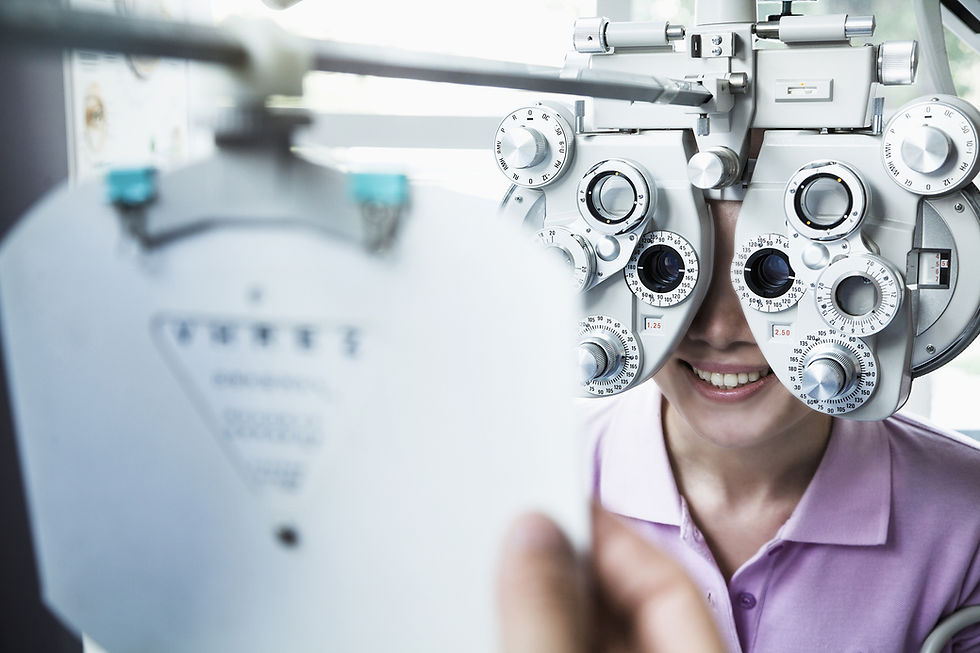An eye examination is a series of tests performed to assess vision and ability to focus on and discern objects.
It also includes other tests and examinations pertaining to the eyes.
Eye examinations are primarily performed by an optometrist, ophthalmologist, orthoptist, or an optician.

What are the difference between the different practicians?
Opticians are technicians who fit eyeglasses, contact lenses, and other vision-correcting devices.
Optometrists examine, diagnose, and treat patients' eyes.
Ophthalmologists are eye doctors who perform medical and surgical treatments for eye conditions. They specialize in treating eye health problems, such as dry eye syndrome, eyelid conditions such as blepharitis and styes, cataracts, diabetic eye disease, glaucoma or macular degeneration.
What does a full eye exam include? A comprehensive adult eye examination includes,
Patient and family health history.
Visual acuity measurement.
Preliminary tests of visual function and eye health, including depth perception, color vision, peripheral (side) vision and the response of the pupils to light.

How a Standard Eye Test is Performed? First, you will be asked if you are having any eye or vision problems.
You will be asked to describe these problems, how long you have had them, and any factors that have made them better or worse. Your history of glasses or contact lenses will also be reviewed.
The eye doctor will then ask about your overall health, including any medicines you take and your family's medical history. Next, the doctor will check your vision (visual acuity) using a Snellen chart.
You will be asked to read random letters that become smaller line by line as your eyes move down the chart.
Some Snellen charts are actually video monitors showing letters or images.
To see if you need glasses, the doctor will place several lenses in front of your eye, one at a time, and ask you when the letters on the Snellen chart become easier to see. This is called a refraction.
Other parts of the exam include tests to:
See if you have proper three-dimensional (3D) vision (stereopsis).
Check your side (peripheral) vision.
Check the eye muscles by asking you to look in different directions at a penlight or other small object.
Examine the pupils with a penlight to see if they respond (constrict) properly to light.
Often, you'll be given eye drops to open up (dilate) your pupils. This allows the doctor to use a device called an ophthalmoscope to view the structures at the back of the eye. This area is called the fundus. It includes the retina and nearby blood vessels and optic nerve.
Another magnifying device, called a slit lamp, is used to:
See the front parts of the eye (eyelids, cornea, conjunctiva, sclera, and iris)
Check for increased pressure in the eye (glaucoma) using a method called tonometry

How often should one go for an eye exam?
Babies (Age 3 and below): Ensure that your child’s eyes are screened during regular paediatric appointments. Some common childhood eye conditions to look out for include strabismus (crossed eyes) and amblyopia (lazy eye). Screening is also performed to exclude rarer diseases such as congenital cataract and retinoblastoma (eye tumour).
Children and Teenagers (Age 3 to 19): Ensure that your child has a thorough eye check every one to two years during routine health check-ups or when getting fitted for corrective eyewear, such as for myopia.
Young Adults (Age 20 to 39): Have a comprehensive eye examination if you have a family history of eye disease or if you are suff ering from an eye injury.
Adults and Seniors (Age 40 to 64): As you get older, age-related eye conditions are more likely to occur. To monitor vision changes, you should get a baseline eye disease screening when you are 40 and ask the doctor to assess how often you need to return for follow-up screenings.
For Anyone with Risk Factors: If you have a risk factor for eye disease (are diabetic, have high blood pressure, have a family history of eye disease, or are taking prescription medications which may affect the eyes) you should see your ophthalmologist more frequently. Ask your eye doctor for the ideal interval between check-ups.

Source:

Comments